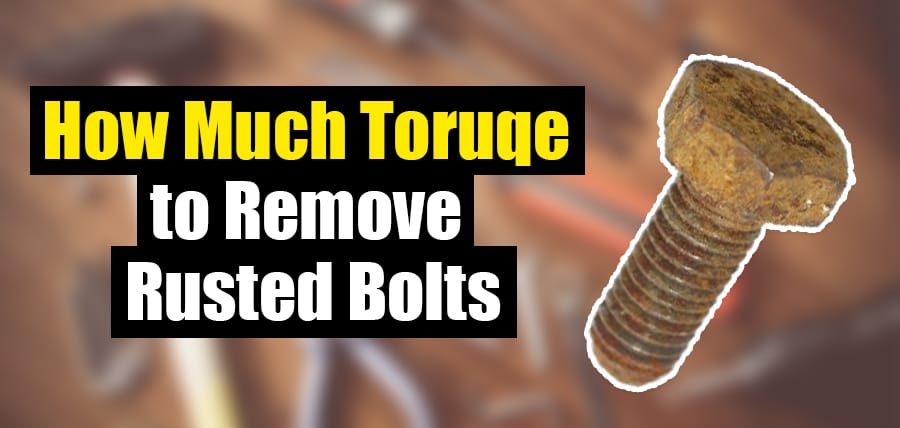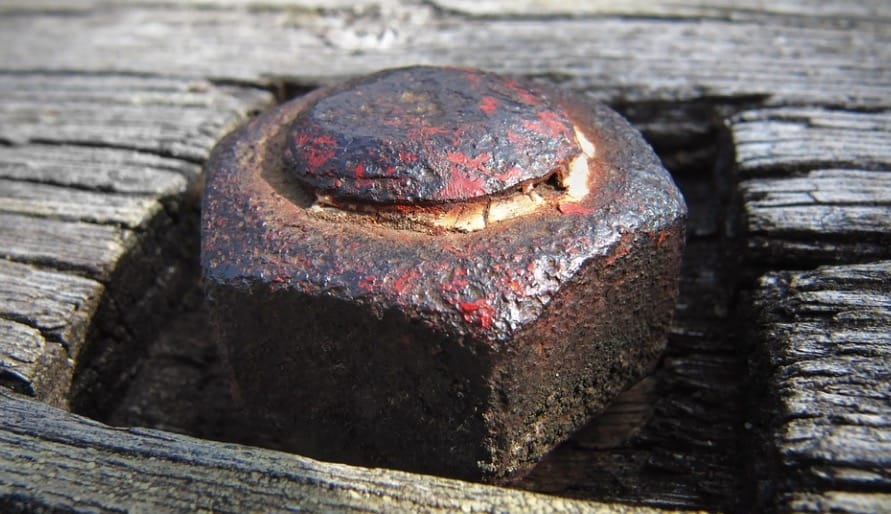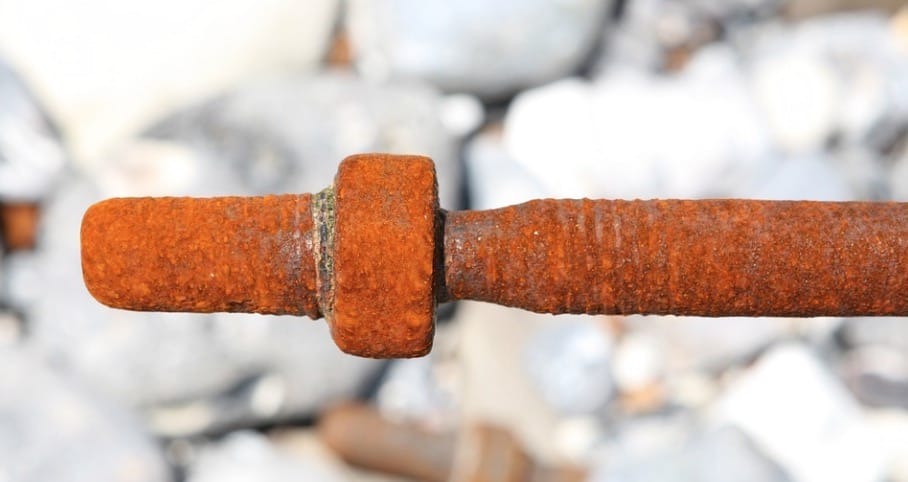Today, we dive into the rusted abyss of bolt removal, exploring the nooks and crannies of corrosion and the torque needed to send those stubborn suckers packing.
We’ll reveal the secrets of setting the perfect torque for rusted bolts, the tools that’ll help you become the rust-busting champion (e.g. impact wrench), and some handy tips to ensure you’re not wrestling with rusty metal for hours on end.
Let’s get started!
How Much Torque to Remove Rusted Bolts
Looking to remove a rusted bolt with a high-torque impact wrench?
We all know that rusted bolts are hard to break loose because the corrosion forms a strong bond between the bolt and the surrounding material, increasing friction
So, if you want to remove a rusty bolt with an impact wrench then you’d better know that it’s all about applying just the right amount of torque.
Too little torque won’t break the rust bond, while too much can strip or break the bolt, making removal more difficult and potentially harming the bolt itself or the tool’s internal components.
Let’s break down what will allow you to set the right amount of torque to remove a rusty bolt:
- Size of bolt: Big bolt? It’s going to need more torque. Small bolt? Not so much. It’s that simple
- Assessing the rust situation: Is it a light dusting of rust or a full-on rust invasion? The more rust, the more torque you’ll need to break that bolt free as rust increases friction and creates a stronger bond between the threads
- Bolt material: A stainless steel bolt won’t budge as easily as an aluminum one as stainless steel is a harder and stronger material than aluminum, resulting in a higher resistance to torque
- Rust age: Older bolts have had more time to become one with the rust, so they might need a bit more torque to break them loose
- Thread engagement: The more threads that are gripping the bolt with the rust, the more torque you’ll need to unclench that rusted bolt
Common Torque Values for Removing Rusted Bolts
Getting to learn typical torque values for yanking out those pesky rusted bolts is crucial.
Why?
Well, it clues you in on just the right amount of force your impact wrench has to output to pry those stubborn suckers loose without wrecking anything in the process
This knowledge can ensure a successful and efficient bolt removal process.
So, here are some examples of different torque levels for different types of rusted bolts:
- A 1/2-inch bolt with light rust may require around 100 ft-lbs of torque to break it free.
- A 3/4-inch bolt with moderate rust may require around 250 ft-lbs of torque to break it free.
- A 1-inch bolt with heavy rust may require around 500 ft-lbs of torque to break it free.
- A stainless steel bolt with moderate rust may require around 800 ft-lbs of torque to break it free.
It’s important to note that these are just general guidelines, and the actual torque required may vary based on a number of factors.
I’d say start with your impact wrench at the lowest torque setting and give it a whirl. No luck? Crank it up a notch and try again. Keep inching up that torque, bit by bit, until that rusty bolt finally surrenders, that way, you’ll avoid causing any unnecessary damage to the bolt or surrounding components.
What Tools to Use to Remove Rusted Bolts
When it comes to removing rusted bolts, having the right tools can make the job much easier as without them, you’re like a lost lamb in a field of rusty metal.
The right tools help you tackle these stubborn bolts with precision and finesse, saving you time, energy, and potentially a whole lot of frustration.
Here are some of the essential tools to consider:
- Penetrating oil: Before you start working on the rusted bolt, it’s important to apply a penetrating oil to help loosen the rust seeping into the nooks and crannies, giving that rust a one-way ticket out of town. Some popular options include PB Blaster, Liquid Wrench, and WD-40
- Heat gun: If the penetrating oil isn’t enough to loosen the bolt, applying heat with a heat gun can help break up the rust as the heat causes metal to expand, creating a little extra wiggle room for that rusted bolt to break free from its iron grip. Just remember, you’re heating the area around the bolt, not the bolt itself
- Impact wrench: An impact wrench can be a game-changer when it comes to removing rusted bolts as it has high-torque action which can often break the rusted bolt loose without damaging the surrounding area
- Vise-grips or locking pliers: If the bolt is too rusted to remove with an impact wrench, vise-grips or locking pliers can be used to get a better grip on the bolt and turn it
- Bolt extractor: For really stubborn rusted bolts, a bolt extractor can be used to grip the bolt and turn it out. These little wonders grip onto the stubborn bolt with a vice-like grip, allowing you to crank it out with a wrench or socket. These can be found at most hardware stores and come in a variety of sizes to fit different bolts.
Tips for Removing Rusted Bolts
Removing rusted bolts can be a time-consuming and difficult task, which is why I thought I might give you these nice few tips that I wish I had known earlier.
Here they are:
- Be patient: It’s important to have patience when dealing with rusted bolts. Rushing the process can lead to stripped or broken bolts, which will make the job even more difficult
- Tap the bolt: Lightly tap the bolt with a hammer or mallet to help loosen the rust. Be careful not to hit the bolt too hard, as this can damage the surrounding area or the bolt itself
- Use a breaker bar: A breaker bar can provide more leverage than a traditional wrench, making it easier to break loose rusted bolts. Make sure to use a socket that fits the bolt head snugly as you’ll get even more leverage
- Try an impact wrench: An impact wrench is a powerful tool that can provide high-torque action to break loose rusted bolts. Make sure to use the right size socket and be careful not to overtighten the bolt
- Try a bolt extractor: If the bolt won’t budge with a breaker bar or impact wrench, consider using a bolt extractor. These tools grip the bolt tightly and allow you to turn it with a wrench or socket
- Prevent future rust: Once you’ve removed the rusted bolt, take steps to prevent future rust from forming. Apply a rust inhibitor or coat the area with a rust-resistant paint to help protect the metal
Frequently Asked Questions
Here are some of the most frequent questions I came across when discussing how to remove rusted bolts.
Let’s give it a shot and try to answer them.
Is it possible for an impact wrench to remove rusted bolts?
Yes, an impact wrench can remove rusted bolts.
The tool’s high torque output and rapid hammering action can break the rust bond, making it easier to loosen and remove the bolt.
However, I’d highly recommend to also use penetrating oil or rust-dissolving solutions to help break down the rust and protect the threads before attempting to use the impact wrench.
What is the method for extracting heavily corroded bolts?
To remove severely rusted bolts, follow these steps:
- (Optional) Apply a rust penetrant or a rust-dissolving solution to the bolt and let it sit for a while, allowing the solution to work on the rust, so the bolt is easier to remove later
- Use a wire brush or steel wool to clean the area around the bolt, removing as much rust as possible
- Use the appropriate socket or wrench to attempt to loosen the bolt. Apply steady, even pressure to avoid breaking the bolt.
- If the bolt remains stuck, use an impact wrench or a breaker bar for additional leverage and torque.
- If the bolt still won’t budge, carefully apply heat to the surrounding area with a propane torch to expand the metal and break the rust bond. Exercise caution to avoid damaging other components or even yourself!
- In extreme cases, you may need to drill out the bolt or use a bolt extractor tool.


